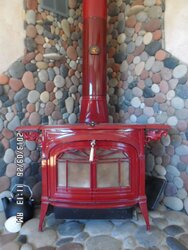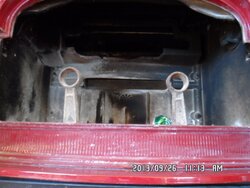I bought a home with this stove in the upper level. The main upper level is about 1,000 SF. The stove sits to one corner of that level. The bottom level is another 1,000 SF. I live in central Colorado at about 6,000 feet elevation.
I've only burned it twice thus far. I have never used wood stoves before so I am learning. Please tell me how this sounds, performance wise. I am pondering a new stove, and want to know if I should consider canning or repairing this one which has a burned up damper assembly and bad CAT element. The damper will not close and even if it did the previous owner said the CAT was bad and air would not flow through it right (making it useless, plus he said smoke would come out even if attempted):
Tonight it got down to 35 degrees so I fired up the Vermont Castings stove for the 2nd time. I have a magnetic thermometer about 18" up the pipe, and another in the center of the top plate (center top of stove). Here is two pics of stove with the damper defect I spoke of and I have a CL ad to sell it here:
https://post.craigslist.org/manage/4092950715
I loaded it up about 4/5 full with small, medium and large size pieces of really dry wood. It lit real quick, had good draw, and I closed the doors right away. As it was going I tested the draw with the top plate slightly open as well as one front door...it worked well. I had the primary air thermostat all the way open for max oxygen. In about 20 minutes it had reached about 550 degrees in the pipe and same on stove.


This is the high end of the "optimum temp range" my thermometer states so I closed the air thermostat all the way to restrict air in hopes to tame it. It continued to rise quickly, as if that had no effect. About 5 minutes later the temp in the pipe had climbed to about 750 - 800 degrees and it was about 800 on the top center of the stove. I got a bit nervous. Then, about 5 or 10 minutes later the pipe started to cool and it dropped to within the optimum operating range (about 500 degrees) in the pipe, but stayed about 700 degrees on the stove. So I got off my fire-fighter gear and chilled, lol.
I took temp readings with a room thermometer after the stove peaked. It read 135 degrees at the sides of the stove (on outer ends of mitten dryer racks). About 18 feet away it was about 80. About 4 feet it was 90. Before I fired it up, the entire room was about 70.
The first batch of wood fire burned about 1.25 hours before it was just small hot embers. I added one more medium size piece of wood and that burned for about 35 minutes before it pretty much went out and was embers too.
How is this operation compared to your experiences? Was my high heat point too hot for that short period? Should I reduce the amount of the first fill-up to reduce the temp on the first burn? Maybe fill the fire pit about 1/2 rather than 4/5?
How about the burn time? Was it too short compared to better operating stoves?
As you can see from the pics, the damper door assembly is all burned up. That is where the flames really move across, so makes sense it is basically burned away after 20 years of use.
What are my options for controlling a fire when I have no way to close off the damper? Can I open a door and spray the fire with water? Can I install a stand alone pipe damper that flips open and shut at my command? At present all I have is chemical fire extinguishers and those Firex sticks you light and toss in (to rob the fire of oxygen). Those are not cheap...like $30 a piece. Looks like a jumbo sized roadside flare.
Thanks much!
Chris
I've only burned it twice thus far. I have never used wood stoves before so I am learning. Please tell me how this sounds, performance wise. I am pondering a new stove, and want to know if I should consider canning or repairing this one which has a burned up damper assembly and bad CAT element. The damper will not close and even if it did the previous owner said the CAT was bad and air would not flow through it right (making it useless, plus he said smoke would come out even if attempted):
Tonight it got down to 35 degrees so I fired up the Vermont Castings stove for the 2nd time. I have a magnetic thermometer about 18" up the pipe, and another in the center of the top plate (center top of stove). Here is two pics of stove with the damper defect I spoke of and I have a CL ad to sell it here:
https://post.craigslist.org/manage/4092950715
I loaded it up about 4/5 full with small, medium and large size pieces of really dry wood. It lit real quick, had good draw, and I closed the doors right away. As it was going I tested the draw with the top plate slightly open as well as one front door...it worked well. I had the primary air thermostat all the way open for max oxygen. In about 20 minutes it had reached about 550 degrees in the pipe and same on stove.


This is the high end of the "optimum temp range" my thermometer states so I closed the air thermostat all the way to restrict air in hopes to tame it. It continued to rise quickly, as if that had no effect. About 5 minutes later the temp in the pipe had climbed to about 750 - 800 degrees and it was about 800 on the top center of the stove. I got a bit nervous. Then, about 5 or 10 minutes later the pipe started to cool and it dropped to within the optimum operating range (about 500 degrees) in the pipe, but stayed about 700 degrees on the stove. So I got off my fire-fighter gear and chilled, lol.
I took temp readings with a room thermometer after the stove peaked. It read 135 degrees at the sides of the stove (on outer ends of mitten dryer racks). About 18 feet away it was about 80. About 4 feet it was 90. Before I fired it up, the entire room was about 70.
The first batch of wood fire burned about 1.25 hours before it was just small hot embers. I added one more medium size piece of wood and that burned for about 35 minutes before it pretty much went out and was embers too.
How is this operation compared to your experiences? Was my high heat point too hot for that short period? Should I reduce the amount of the first fill-up to reduce the temp on the first burn? Maybe fill the fire pit about 1/2 rather than 4/5?
How about the burn time? Was it too short compared to better operating stoves?
As you can see from the pics, the damper door assembly is all burned up. That is where the flames really move across, so makes sense it is basically burned away after 20 years of use.
What are my options for controlling a fire when I have no way to close off the damper? Can I open a door and spray the fire with water? Can I install a stand alone pipe damper that flips open and shut at my command? At present all I have is chemical fire extinguishers and those Firex sticks you light and toss in (to rob the fire of oxygen). Those are not cheap...like $30 a piece. Looks like a jumbo sized roadside flare.
Thanks much!
Chris
Last edited by a moderator:

